Provenance: Center for History and Paleography (National Bank of Greece Cultural Foundation/MIET, Athens and Princeton University Library Special Collections (Princeton, NJ)
By Dr. Venetia Chatzopoulou, Center for History and Palaeography of the National Bank of Greece Cultural Foundation

Center for History and Palaeography (MIET), Pezaros MS 53
Proskynetaria: a particular genre of manuscripts
Pilgrim’s guidebooks to the Holy Land date back to the 4th century C.E. Written in several languages, those in Greek are called Proskynetaria due to the first word of their title in most manuscript witnesses:
Προσκυνητάριον σὺν Θ(ε)ῷ ἁγίῳ τῆς ἁγίας πόλεως Ἱ(ερουσα)λήμ …
[Proskynitarion syn Theo hagio tes hagias poleos Hierousalem …].

Princeton Greek MS 31 – Courtesy of Princeton University Library
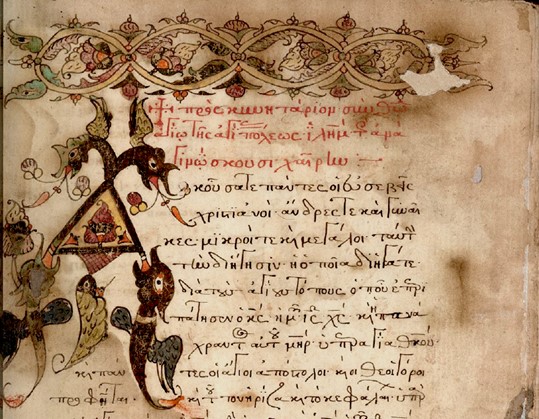
They appeared in the 16th century and proliferated considerably during the 17th-18th centuries, until the prevalence of the printed manuals for pilgrims. Each Proskynetarion presents a considerable number of Christian monuments in Jerusalem and in other areas of Palestine as well: the description of the complex of the Church of the Holy Sepulchre in Jerusalem prevails while other important sites of worship in the Holy City (e.g. the Praetorion, the House of Saints Joachim and Anna, the Pool of Bethesda, various churches and monasteries) and in the outskirts (e.g. the Holy Zion, the Mountain of Olives, Gethsemane) are outlined too. The narrative proceeds to other cities popular with pilgrims and monasteries of Palestine (e.g. Bethlehem, Nazareth, the Holy Lavra of St. Savvas) and it normally ends up at the port of Jaffa, the point of arrival and departure of those who had chosen the maritime route for their journey to the Holy Places.
The ceremony of the Holy Light at the Church of the Holy Sepulchre, details on the architecture of the sacred monuments, the property rights over the shrines and the distances between them which the pilgrims needed to take into consideration, is some of the additional information included in the Greek manuscript guidebooks.
The descriptions are plain but clear, the language is the vernacular, the text is in prose (rarely in verses). The accounts derive from older manuscripts of this kind and do not present considerable variety, although there are some differences in their content which are due to the personal experience and knowledge of the manuscripts’ authors/scribes. These seem to be natives of Palestine, mainly monks with a solid knowledge of the places of veneration.
Proskynetaria were aiming to attract pilgrims to the Holy Land but were considered to be beneficial to the soul as readings as well. Among them, those which were illustrated constitute a special category which stimulates the interest of the readers and attracts a larger public of customers. They are mainly delivered anonymously. Only in a few cases are we familiar with the name of the scribe thanks to manuscript notes left in the volume.[1]
Twin Proskynetaria in two different continents : a case study
In the present study we will present two witnesses of this particular genre of manuscripts. The first one belongs to the lot of manuscripts of Ioannis Pezaros, an 18th century Greek cleric and teacher in Thessalia, whose rare book collection was briefly presented at the CERL blog in a previous post. Both the manuscript and rare book collection of Ioannis Pezaros are nowadays kept at the Center for History and Palaeography of the National Bank of Greece Cultural Foundation (MIET, Athens). The Proskynetarion under examination (Pezaros MS 53) comprises 18 folios in all and is currently mutilated at its beginning and end.
The second Proskynetarion is conserved in the Princeton University Library, Special Collections Department, in Princeton, NJ (Princeton Greek MS 31). It consists of 20 folios and has the benefit of preserving the scribe’s name and the date of the copy at the end of the book: this manuscript was transcribed by an hieromonk named Dionysios in 1695 (10th August).

1695 ἐν μηνὶ Αὐγούστου 10. Χεὶρ Διονυσίου ἱερομονάχου
[10 August 1695. In the hand of Dionysios hieromonk]
Princeton Greek MS 31 – Courtesy of Princeton University Library
Both manuscripts are abundantly illustrated and present an obvious resemblance to one another, which was initially pointed out in the description of the Princeton manuscript in the electronic catalogue of the Princeton University Library: “The unsigned proskynetarion held at the National Bank of Greece Cultural Foundation is apparently by the same scribe”. Indeed, a comparison between the two witnesses allows us to verify that they were both written in the same hand and present the same upright, sizable script with ligatures and abbreviations in brown ink, while the titles and initials are marked in red and some decorative details are filled with gold (e.g. fig. 5). With the exception of minor differences in the text (addition, omission or replacement of a word/phrase by another) and the spelling, their content is identical too and so are their drawings which depict the same sites by using the same patterns, with some differences only with regard to the colors chosen for the illustration of the monuments and to a few decoration elements.
Based on the resemblances cited above, we can now proceed to the dating of the Proskynetarion in Athens at a more precise period of time, approximately close to that of the copying of the Princeton manuscript, i.e. at the end of the 17th century (or at the beginning of the following one).
The Pezaros manuscript, which is probably mutilated of 2 folios at the beginning and 2 folios at the end of the volume, encompasses 49 illustrations in all. On the other hand, the Princeton Proskynetarion seems to lack one folio – after the first folio of the manuscript – and it is important to point out that it comprises drawings which are nowadays absent from the mutilated codex in Athens: the church of Saint George in Lydda, the church of Saint George in Ramla and Joppa (Jaffa).
The scribe neither copies nor illustrates mechanically one witness from the other: there are differences in the layout of the text and the distinct way in which he decided to portray one of the miniatures (Lake Tiberias; fig. 8a, 8b) proves his willingness to attribute a particularity to each copy.
Both manuscripts -most likely created for commercial reasons- are excellent examples of illustrated Greek pilgim’s guidebooks, witnesses of an artistic and calligraphic quality and precious samples of a popular art that was developed in the 17th century.
Some of the miniatures decorating the two Proskynetaria are cited below:
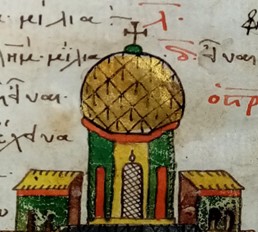
Center for History and Palaeography (MIET), Pezaros MS 53

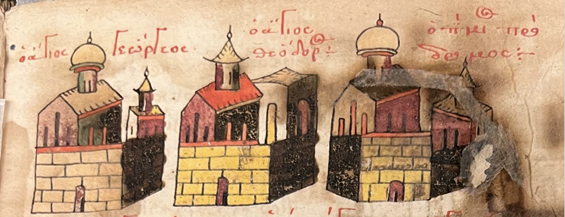
The Holy Monasteries of Saint George, Saint Theodore, Saint John the Baptist (in Jerusalem)
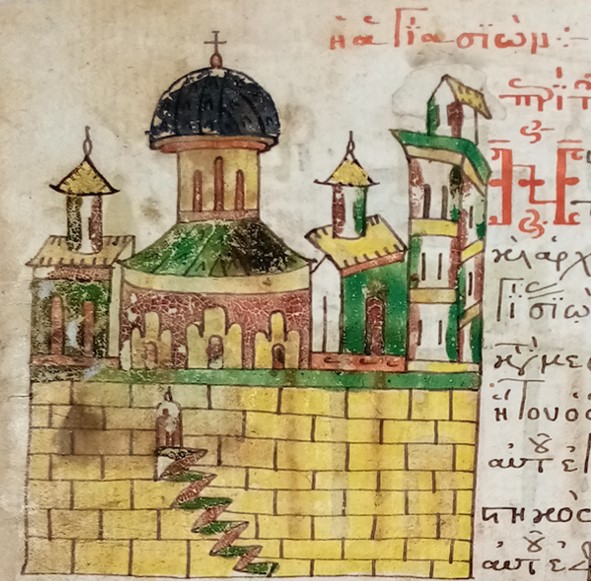
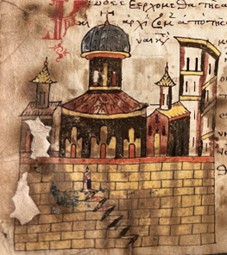
Hagia Sion (The Holy Zion)
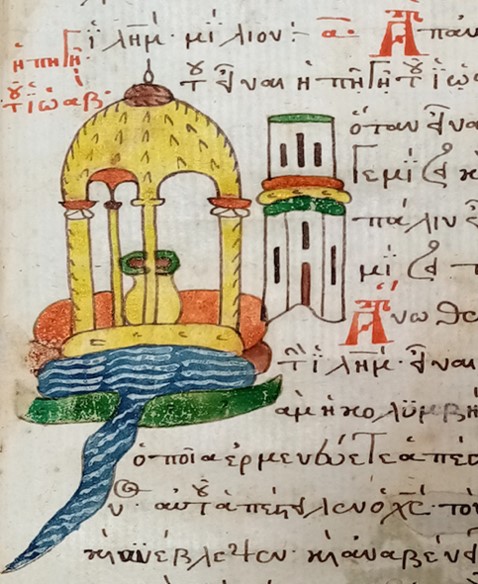

Joab’s Source
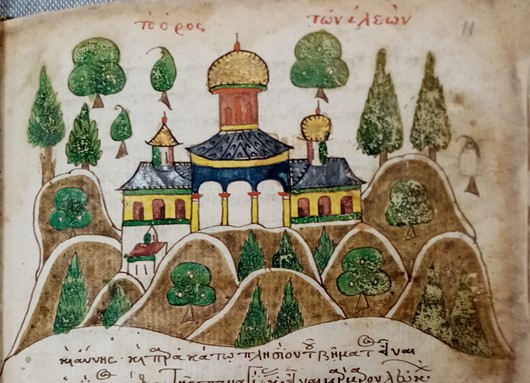
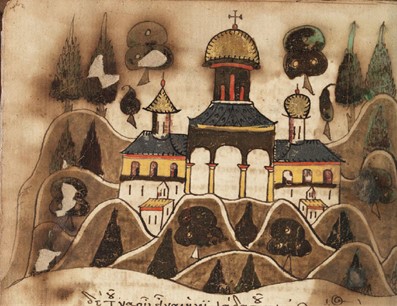
The Mount of Olives
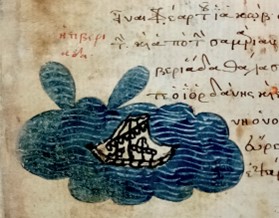

Lake Tiberias (in Galilee)
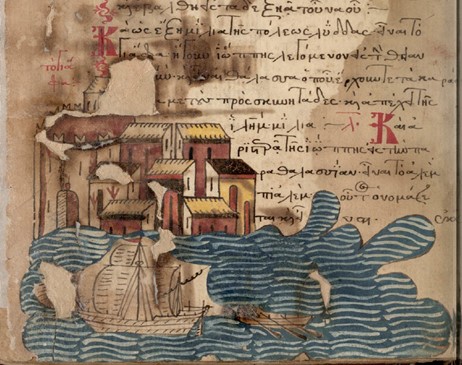
Princeton Greek MS 31 – Courtesy of Princeton University Library
Special thanks to:
Princeton University Library for facilitating my research by providing me with the Princeton Greek MS 31 in digitized form.
My dear friend Mrs Athina Yfanti, teacher of English, for revising the English text of this presentation.
[1] Important information on the Proskynetaria is drawn from Sotiris Kadas, Προσκυνητάρια των Αγίων Τόπων. Δέκα ελληνικά χειρόγραφα 16ου-18ου αι., Thessaloniki 1986; idem, Οι Άγιοι Τόποι. Εικονογραφημένα προσκυνητάρια 17ου-18ου αι., Athena 1998. See also Andreas Külzer, Peregrinatio graeca in Terram Sanctan. Studien zu Pilgerführen und Reisebeschreibungen über Syrien, Palästina und den Sinai aus byzantinischer und metabyzantinischer Zeit, Frankfurt a. M. / Berlin / New York / Paris / Wien 1994.
